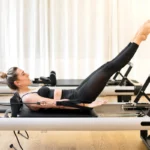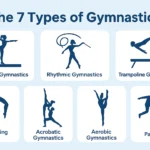Gymnastics in the United States follows a clearly defined structure that helps young athletes grow from beginners into national competitors, and, for some, even Olympians.
This guide walks you through the different qualification paths in the USA Women’s Gymnastics system, including the Development Program (DP), the Xcel track, the Hopes program, and the journey into elite and international competition.
1. Women’s Development Program (DP)
The vast majority of U.S. gymnasts begin their journey in the Women’s Development Program, a structured system divided into ten levels. These levels guide athletes from basic skills to high-level routines, preparing them for collegiate or elite gymnastics.
Levels 1–3: Foundation Building
Levels 1 through 3 focus on basics such as body alignment, rolls, handstands, cartwheels, and posture. Many gyms use these levels for in-gym evaluation only, but some states sanction Level 1–3 competitions. These meets don’t lead to higher championships but provide experience and feedback in a judged environment.
Levels 4–6: The Start of Competition
Formal competition begins at Level 4, where routines are compulsory (the same for every gymnast). Advancement is score-based:
- Level 4 → Level 5: 34.00 All-Around (AA)
- Level 5 → Level 6: 32.00 AA
- Level 6 → Level 7: 32.00 AA
Fast-Track Option: Gymnasts who earn two 36.00+ AA scores at Level 4 may skip directly to Level 6.
Age Requirements: Gymnasts must be at least 7 years old to compete Level 4. With talent and dedication, some athletes reach Level 10 by age 11 or 12.
Levels 7–10: Optional and Elite Preparation
At Level 7, routines become optional, meaning gymnasts and coaches choreograph routines using skills chosen from the Code of Points. This system rewards creativity and highlights strengths.
- Levels 7–8: Regional and State competitions are the pinnacle.
- Level 9: Leads to Easterns or Westerns.
- Level 10: Culminates in DP Nationals. Level 10 gymnasts often attract NCAA recruiters.
For athletes with elite ambitions, Level 10 is the launching point into the separate Elite Program.
2. The Xcel Program (Flexible, Popular Alternative)
The Xcel Program offers a flexible alternative to DP. It is divided into six divisions: Bronze, Silver, Gold, Platinum, Diamond, and Sapphire.
Key differences from DP:
- Routines: Always custom (no compulsory levels).
- Commitment: Training hours are typically lighter, making it ideal for multi-sport athletes or those who start gymnastics later.
- Advancement: Coach-assessed and score-based within Xcel, but does not transfer into DP mobility.
| Feature | Development Program | Xcel Program |
|---|---|---|
| Routine Type | Pre-set (Lv 1–5), Custom (Lv 6–10) | Custom from the start |
| Time Commitment | High | Moderate to Light |
| Advancement | Strict, score-based | Flexible, coach + score |
| Athlete Type | NCAA/Elite hopefuls | Recreational/Flexible |
Xcel is optional in every sense. It doesn’t lead to elite qualification, but it provides gymnasts with the chance to compete, progress, and achieve personal milestones.
3. Bridging the Gap — The Hopes Program
Between Level 10 and full Elite status lies the Hopes Program. Often described as a preview of Junior Elite, Hopes gives promising young gymnasts a chance to experience elite-style competition with slightly modified standards.
Who Is Eligible?
- Age Groups:
- 11–12
- 13–14
- Qualifying Scores (at National Elite Qualifiers):
| Age Group | Compulsory Score | Optional AA Score | Path Forward |
|---|---|---|---|
| 11–12 | 32.00 | 43.50 | Top 18 at Hopes Classic → Hopes Championships |
| 13–14 | 33.00 | 45.00 | Top 18 at Hopes Classic → Hopes Championships |
Hopes routines use slightly lowered apparatus settings and shorter tumbling passes, making the transition into Elite more approachable.
In short, Hopes serves as both a proving ground and a preparation platform for future Elites.
4. Earning Elite Status
Reaching Elite status is one of the most significant milestones in a gymnast’s career. It’s the official gateway into the highest tier of competition—where athletes become eligible for National Team selection, international assignments, and even the Olympics.
Two-Part Requirement: Compulsory + Optional
At a National Elite Qualifier, gymnasts must meet both:
- Compulsory Score (once per season): 35.00 AA
- Compulsories are standardized routines judged on execution.
- Once passed in a season, they carry forward (no need to repeat).
- Optional Scores (AA or Event Specialist):
| Category | All-Around (AA) | 2-Event Score | 3-Event Score |
|---|---|---|---|
| Junior (11–15) | 48.00 | 26.80 | 39.60 |
| Senior (16+) | 50.00 | 26.60 | 39.30 |
Multiple Paths
- All-Around Track: Athletes meeting the AA score can compete in all four events.
- Specialist Track: Athletes qualifying with 2- or 3-event scores are limited to those events for the season. This allows standout bar or beam specialists to enter elite competition without mastering all four events at once.
5. The Roadmap of Elite Meets
Once a gymnast earns elite status, she enters a ladder of high-stakes competitions:
- National Qualifiers (Jan–Jun): Last chance to pass compulsories or hit optional scores.
- Winter Cup (Feb): First major national meet. Strong AA finishers are considered for National Team, though selection also involves committee discretion.
- American Classic & U.S. Classic (Spring): Mid-season qualifiers and checkpoints. Gymnasts can upgrade scores to reach the U.S. Championships standard.
- U.S. Championships (Summer): The season’s pinnacle. Determines:
- National Champions
- National Team selections
- Olympic Trials invitations (in Olympic years)
Championship Qualifying Scores
- Junior Elite: 49.00 AA
- Senior Elite: 52.00 AA
6. National Team & International Assignments
Selections occur after Winter Cup and again after U.S. Championships.
- Roughly 15–20 gymnasts are named to the team across juniors and seniors.
- Selections weigh:
- Rank order and scores
- D-scores (difficulty potential)
- Consistency/hit percentage
- Readiness for international competition
National Team members gain access to funding, medical care, training camps, and international assignments such as FIG World Cups, Pan Ams, and World Championships.
7. Olympic Trials & Team Selection
Every four years, the road narrows to the Olympic Trials.
- Eligibility: Must turn 16 in the Olympic year, hold a U.S. passport, and an active FIG license.
- Invitations:
- The top two all-around finishers at U.S. Championships automatically advance to Trials.
- Additional gymnasts are invited by the Athlete Selection Committee’s discretion.
- Automatic Spot: The winner of Olympic Trials secures an automatic berth on the U.S. Olympic Team.
- Final Roster: The rest of the team is chosen by the Selection Committee, weighing scores, consistency, event needs, and international readiness.
Since 2012, the core sequence has remained:
Winter Cup → Classics → U.S. Championships → Olympic Trials.
Quick FAQs for Parents & Athletes
Can my athlete skip levels?
Sometimes. Examples: two 36.00 AA at Level 4 can allow a direct move to Level 6; Level 6 can be skipped if the athlete earned 32.00 AA at Level 5. Details and limits are spelled out in Chapter 8.
Can we use Xcel results to move up in DP?
No. Xcel can’t be used to satisfy DP mobility. They are separate programs with separate mobility charts.
Is an all-around score the only way to move up at optional levels?
Not always. At Levels 7–10, there’s an IES (event specialist) route using event-specific thresholds (commonly 8.5 on an event, per the chart) to move up without a full AA.
Who sets State/Regional qualifying scores and divisions?
Your State Administrative Committee (SAC) and Regional Administrative Committee (RAC) set many of those meet-specific standards each season (e.g., State qualifying scores, age groups). Check your state/region pages each fall.
Bottom Line
USA Gymnastics guides athletes through a step-by-step qualification system:
- Development Program builds foundations and feeds into NCAA or Elite.
- Xcel provides a flexible, recreational pathway.
- Hopes bridges the gap between DP and Elite.
- Elite status is earned through compulsories and optional scores, leading to national and international stages.
For the few who rise to the very top, the reward is a place on the U.S. National Team, and for the very best, a chance to represent Team USA at the Olympic Games.
Resource Box: Where to Check the Latest Rules & Scores
Development Program (Levels 1–10)
- Overview of the program: usagym.org/devprogram
- Current Rules & Policies (PDF): usagym.org/rules_policies
(See Chapter 8 for age rules, entry requirements, and mobility scores.)
Xcel Program
- Program overview: usagym.org/xcel
- Xcel Code of Points & rules updates: usagym.org/xcel_code
Hopes & Elite Pathway
- Elite program info & qualification documents: usagym.org/elite
(Includes the latest Hopes & Elite qualification charts.)
National Team & Olympic Selection
- High Performance program & National Team: usagym.org/highperformance
- 2024 Olympic selection procedures (PDF): usagym.org/post/29744













